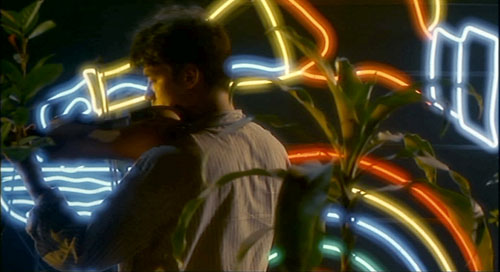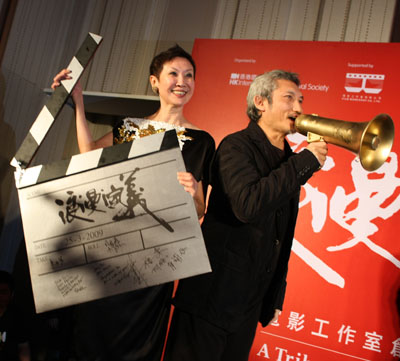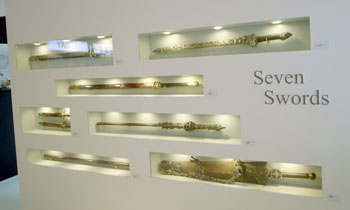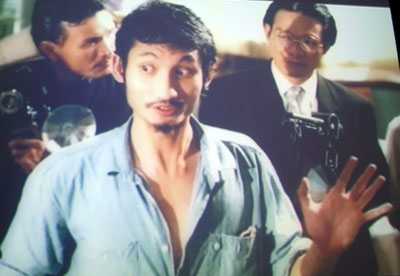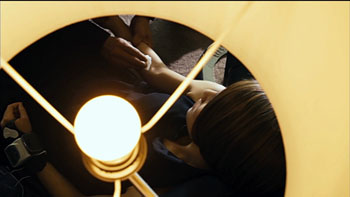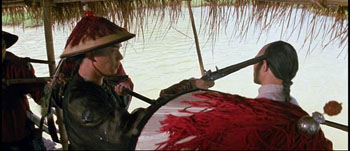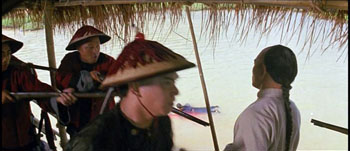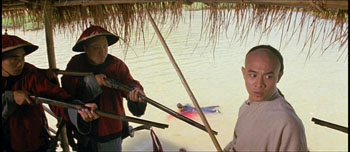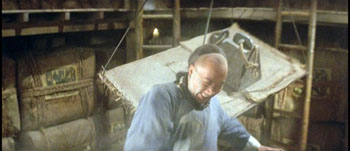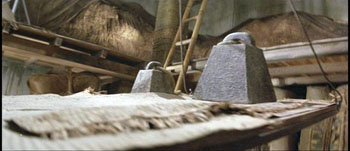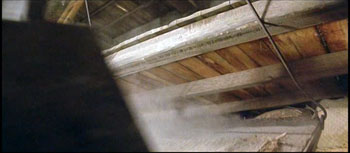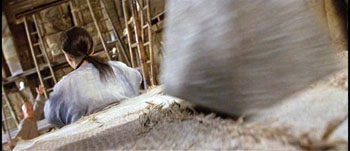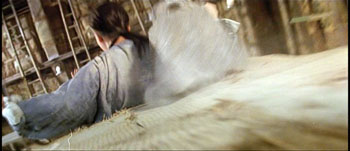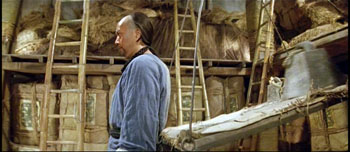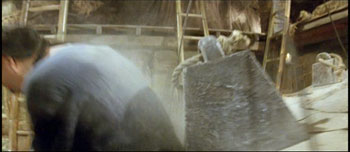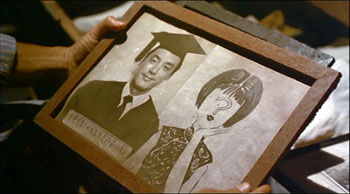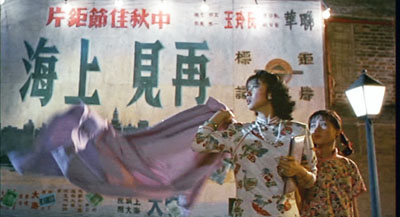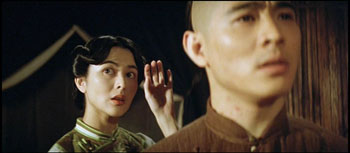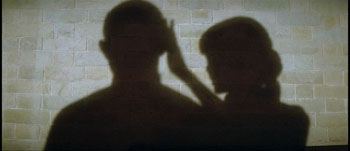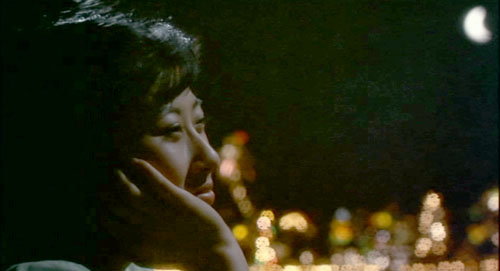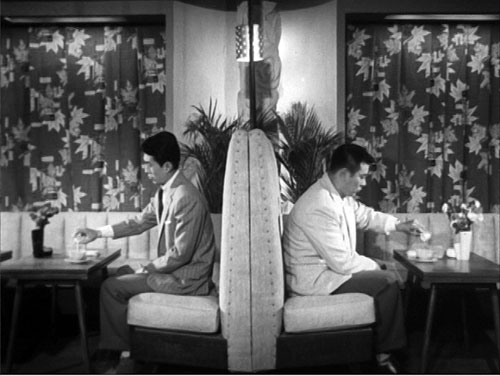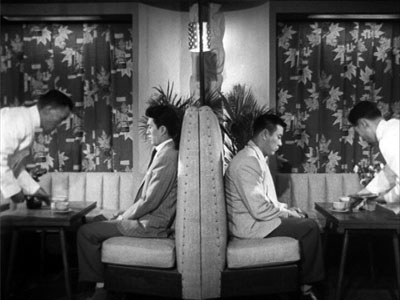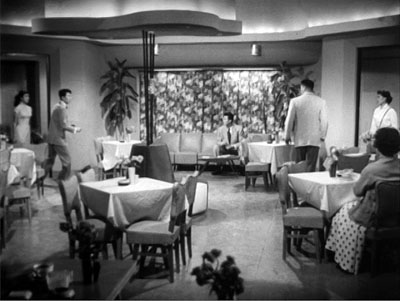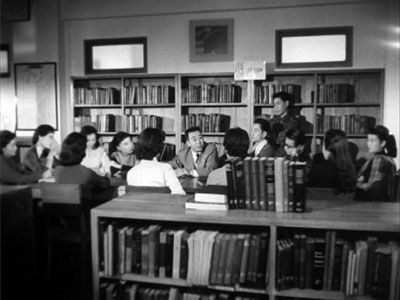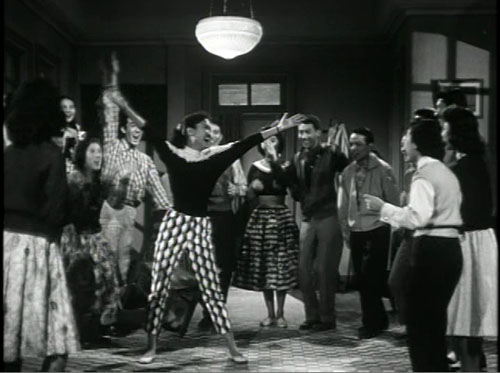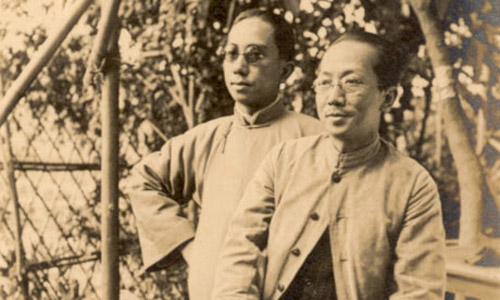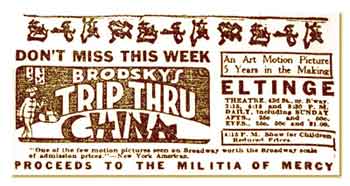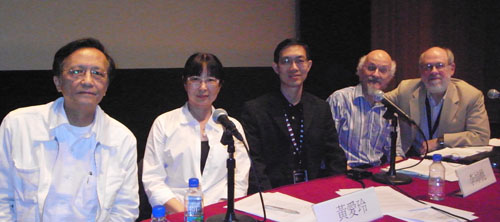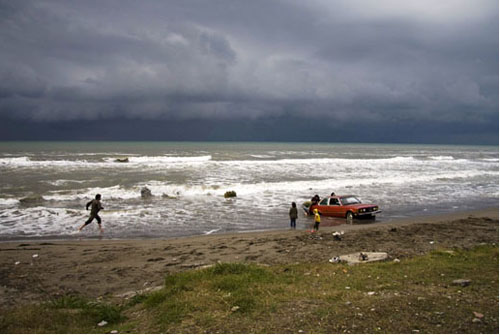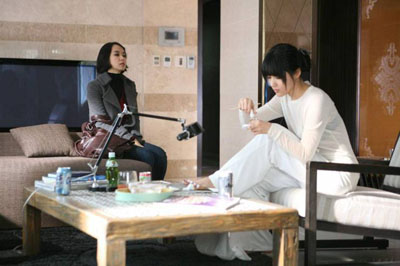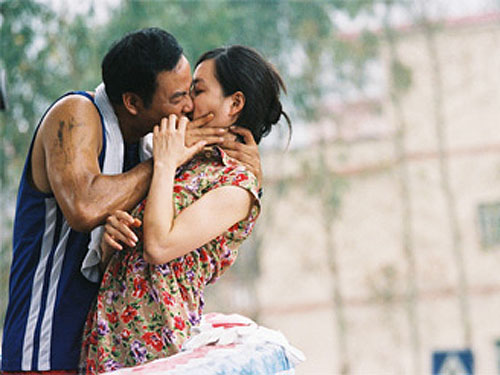Archive for the 'National cinemas: Hong Kong' Category
Happy birthday, Film Workshop
Tsui Hark is the mad genius of Hong Kong cinema. The problem comes with assigning proportions. 10 % mad, 90% genius? 50-50? 99 % mad, 1 % genius?
Across a career that’s lasted more than thirty years, Tsui has had more ups and downs than the local economy. On the twenty-fifth anniversary of Film Workshop, the company he founded, the Hong Kong International Film Festival mounted a tribute. That provides an occasion to examine what he did and didn’t accomplish.
25 years old, but who’s counting?
Nansun Shi and Tsui Hark.
At this year’s Asian Film Awards, Film Workshop was given a special prize for outstanding achievement. On another evening there was a party gathering many Workshop alumi, from which the above photo comes. You can see more pictures from that party here. At the agnes b. gallery, a small show featured posters, a looped video documentary, a photocopy of the Better Tomorrow script, and some memorable props.
Nat Olsen has other pictures at his lively Hong Kong Hustle site.
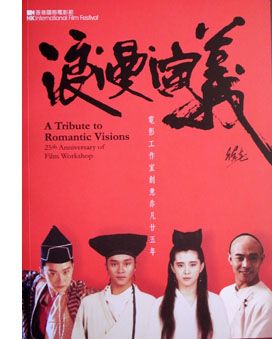 The catalogue, A Tribute to Romantic Visions: 25th Anniversary of Film Workshop, is a must for all aficionados of Hong Kong film. Consisting largely of interviews, it offers many glimpses of creative choices and business strategies governing the company. Nansun Shi, Tsui’s partner and business manager, recalls how they placed films in overseas markets and won critical acclaim in Europe. She also explains matter-of-factly how frantic the midnight-show system was. In those days, Hong Kong filmmakers test-screened a movie to a midnight audience, and then reedited the film based on perceived reaction. Shi explains:
The catalogue, A Tribute to Romantic Visions: 25th Anniversary of Film Workshop, is a must for all aficionados of Hong Kong film. Consisting largely of interviews, it offers many glimpses of creative choices and business strategies governing the company. Nansun Shi, Tsui’s partner and business manager, recalls how they placed films in overseas markets and won critical acclaim in Europe. She also explains matter-of-factly how frantic the midnight-show system was. In those days, Hong Kong filmmakers test-screened a movie to a midnight audience, and then reedited the film based on perceived reaction. Shi explains:
Cinemas often wondered what could be done to a film in the eight hours between the midnight show and the day-time show the next day. I ran some calculation with the technicians: what is the least amount of time for them to do this and that, and then sent them to the cinemas to do the work. If worse comes to worst, they could do the re-editing when the show was running (80).
There isn’t much sugar-coating in the interviews. Collaborators often found Tsui a harsh taskmaster. At peak pressure, he seldom halted shooting for sleep and instead took cat naps on the set. Those who couldn’t keep up his pace, or adjust to his demands, left the company. There are also some comments on production practices. Herman Yau, for instance, notes: “Directors, in general, use most of the shots to tell the story. Tsui prefers images that look good on their own” (121).
Overall, the catalogue confirms that what started as a “workshop” designed to enable directors to realize individual creative visions became a company built around Tsui’s restless ideas about cinema. This was more or less the premise of the panel on Friday afternoon. Two critics, Keeto Lam and Longtin, discussed the Film Workshop enterprise largely as an extension of Tsui’s interests. Keeto had been a screenwriter at the company and shared information about the making of A Chinese Ghost Story 2, while Longtin speculated on Tsui’s interest in transcending polarities, particularly those between human and demon and male and female. Another scriptwriter was in the audience and contributed information as well.
One of Keeto’s points set me thinking. Having characterized Leslie Cheung as the “Golden Boy” of Film Workshop, he asked who the Golden Girl was, and he and audience members discussed candidates for the honor. (My vote, obviously, would go to Brigitte Lin.) But I began to speculate that one of Film Workshop’s main contributions was in star-making. Tsui has mentioned that his early films with gorgeous women tried to create a “comedy of pretty faces” opposed to the “comedy of ugly faces” that ruled in the 1970s and early 1980s. (Think of Michael and Ricky Hui, Karl Maka, Jackie Chan, and Sammo Hung.) By coaxing Brigitte Lin to Hong Kong and by giving Sally Yeh, Leslie Cheung, Chow Yun-fat, and other younger players big roles, Film Workshop created a new generation of glamorous stars.
A better yesterday
This celebration comes at a parlous period in Tsui’s career. Over the last dozen years Tsui directed some weak, even awful movies. Granted, even a bad Tsui movie is bad in a unique way, but that doesn’t make Tri-Star (1996), the Van Damme outings (Double Team, 1997; Knock Off, 1998), and The Legend of Zu (2001) any better. Some films he has produced, like Era of Vampires (2002) and Xanda (2003), are best forgotten. Today, after the only moderate success of Seven Swords (2008) and the disappointments Missing (2008) and All About Women (2008), many local film professionals consider him a spent force.
I’d argue that Tsui and Jackie Chan were the two most ambitious young filmmakers of 1980s Hong Kong. Tsui was the more daring and mercurial; he seemed to be trying a dozen things at once. He made some bad films, but others changed the face of local film: Shanghai Blues (1984), Peking Opera Blues (1986), A Better Tomorrow III (1989), Once Upon a Time in China I and II (1991, 1992), The East Is Red (1993), and The Chinese Feast and The Blade (both 1995). He also produced, and often co-directed, A Chinese Ghost Story and A Better Tomorrow (both 1986), The Big Heat and Gun Men (1988), The Killer (1989), the demented Wicked City (1992), and Iron Monkey (1993). These films had enormous impact locally, and they made Hong Kong film a major force in world cinema.
The problem is the mad-genius thing. Tsui is uneven, not only from film to film but within each one. Tsui can create a fairly unified tone, as The Blade and Seven Swords show. But more likely a Tsui film will contain something brilliant, something banal, something silly, and something just weird. Labored facetiousness is a virus plaguing Hong Kong film generally, but Tsui seems entirely too fond of bursts of dumb comedy. He replies: “Sometimes it’s fun to be stupid.”
Yet the thrown-together quality of many of his movies also means that even a troublesome one is likely to have a passable sequence. More important, his best films use the lurches in tone to create a grotesque, sweeping verve. Things happen so fast you can’t protest; either go with it or walk out.
Tsui’s strategy is based upon a breathless rhythm. He chops off scenes without warning, and he bustles his actors around the set maniacally; the poor things seldom rest long. Almost never do characters simply sit down and talk to one another, as in those bland American indie films. The beginning of Triangle (2007) shows how nervous, even opaque, Tsui’s style becomes when characters have to sit still.
For Tsui, story action is a matter of physical movement, and the film frame becomes a force-field, with actors popping in and out with abandon. He carries the staccato choreography of martial-arts film down to the most straightforward dramatic scene. He’s not alone in this; you can find it in the 1980s martial-arts films too, but Tsui gives it a special force with his pitched angles, his wide-angle lenses, and his love of comic-book-rococo compositions. Try, for instance, this shot of a woman getting an injection in Missing.
Such images can seem merely cheap flash, but what saves the best ones from preciosity is their constant but disciplined rhythm. In Once Upon a Time in China, Wong Fei-hung is about to be arrested after a clash with local thugs. The shot starts with the police official pointing his pistol to Wong’s head.
Another cop comes in to tell the official that the invaders left something. Any other director would have shown the cop’s face, but why? He’s important only to get the official out of the frame, so he becomes just a red hat poking in from the lower right corner.
The official dodges out, moving rightward across the frame.
There’s a pause, then Wong, now isolated in the shot, snaps his head around to follow what’s happening.
Tsui isn’t usually considered an economical director, but it’s hard to imagine a more crisp way to handle this routine bit of action. The shot takes less than eight seconds.
The same restless energy rules Tsui’s cutting, which has a punch and recoil derived, I think, partly from New Hollywood (Spielberg especially; see the Jaws example here) and partly from the local martial arts tradition. (Some proto-Tsui cutting is on display in Lau Kar-leung’s Legendary Weapons of China, 1982.) Watching Once Upon a Time in China at the retrospective, I was reminded that Tsui not only cooks up sequences that you can’t forget (three words: fight on ladders), but he risks audacious cuts on movement that few contemporary directors could bring off. When he wants to emphasize a moment, he channels Eisenstein. During the final combat of Wong and Iron Robe Yim, the iron weight sliding down the platform gets the Potemkin treatment. Four shots stretch out the instant through overlapping movement.
As we might expect, Tsui goes beyond Eisenstein by accentuating major points of impact with swift camera movements forward.
Tsui thinks visually. True, some sound is important—he is a master at merging music and image—but words are a last resort. He has been known to change dialogue in post-production so radically that the dubbing doesn’t match the actors’ lip movements. Shooting without sound gives Tsui, like other Hong Kong directors, a freedom of camera placement that recalls the silent cinema. And like a silent director, he thinks that every story point needs to be pictured. Kenny Bee is looking for the girl he met years ago (Shanghai Blues)? So let’s have an image that dramatizes the problem.
The inclusion of Kenny’s graduation picture might seem superfluous, but it makes the frame an anticipatory wedding picture, and it gives us a sense of his pure, if naïve, romantic impulses.
Motion plus or minus emotion
Shanghai Blues.
If you disapprove of what Spielberg and Lucas did to the American cinema, you will hate Tsui’s love of remakes, sequels, and spinoffs, his frequent confusion of SPFX with imagination, and his efforts to milk franchises to a point that can be considered cynical. Yet historically, he pushed Hong Kong cinema forward.
Before the star-making efforts I’ve already mentioned, indeed before Film Workshop was created, Tsui’s Dangerous Encounters: First Kind (1980) offered a blistering attack on class disparity in Hong Kong. He updated Cantonese fantasy swordplay in Zu: Warriors from the Magic Mountain (1983), and he tried his hand at a local version of low-budget exploitation in We’re Going to Eat You (1980). Keeto’s catalogue essay argues that Film Workshop pioneered six new genres in Hong Kong film, from comic-book adaptations to science-fiction and animation. And there’s more variety than we might expect. Film Workshop directors might have sometimes mimicked his style, but John Woo’s Workshop projects managed to do something quite different. Despite Tsui’s hands-on involvement, the lyrical Iron Monkey and the more hard-edged Gun Men and The Big Heat avoid the eccentricities of his signed work while maintaining his love of flamboyant set-pieces and visual creativity.
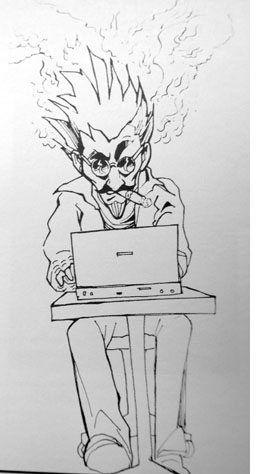 Tsui’s scripts often seem like patchwork, granted, but I tried to show in Planet Hong Kong that the episodic, additive plotline is a convention of Hong Kong cinema. Tsui—like Wong Kar-wai, though in a different key—took advantage of this formula to explore the power of the arresting image and an infectious rhythm. (You might say that Wong’s rhythm is that of cool jazz, while Tsui’s is closer to the percussiveness of Chinese opera.) Shanghai Blues and Peking Opera Blues, two of Tsui’s most ingratiating movies, jump smartly from one thrusting scene to the next, shifting emotional registers with dazzling speed. These movies can turn on a dime.
Tsui’s scripts often seem like patchwork, granted, but I tried to show in Planet Hong Kong that the episodic, additive plotline is a convention of Hong Kong cinema. Tsui—like Wong Kar-wai, though in a different key—took advantage of this formula to explore the power of the arresting image and an infectious rhythm. (You might say that Wong’s rhythm is that of cool jazz, while Tsui’s is closer to the percussiveness of Chinese opera.) Shanghai Blues and Peking Opera Blues, two of Tsui’s most ingratiating movies, jump smartly from one thrusting scene to the next, shifting emotional registers with dazzling speed. These movies can turn on a dime.
Part of what pulls us along is characters we care about—especially strong women. In the old days, we Hong Kong fans used to love the idea that John Woo, carrying on the Chang Cheh tradition, specialized in the sorrows of masculine obligation, while Tsui was much more interested in women. He gave us the comedy of pretty faces, the wide-eyed innocence of Joey Wong, and the severe beauty of Brigitte Lin who, in the final installment of the Swordsman series, becomes a sheer force of nature. (Her bi-gendered role in Ashes of Time stems from Tsui’s creation of her as such in Swordsman II and The East Is Red.) When Tsui took over the Better Tomorrow franchise, his prequel showed that Woo’s ideal hero Mark (Chow Yun-fat) learned his combat crafts from, of all people, a woman. Even the non-stop testosterone fervor of The Blade, all sweaty torsos and clanking weaponry, may be the hallucination of a madwoman.
These were rousing yarns. Yet at some point, I think, Tsui lost interest in telling a story. This tendency can be detected already in the Van Damme projects; the opening of Knock Off revels in visual effects (microscopic close-ups of the ripping fibers inside running shoes) but doesn’t dwell on what we need to know. Tsui’s task in the collaborative film Triangle was to simply to set up the premises of the action, but dialogue-driven exposition seems to bore him, and the opening scene is a frenzy of eccentric angles and barely registered plot points. His SPFX extravaganza The Legend of Zu has a fairly incomprehensible story to begin with, but by swamping it in explosions and magical transformations, Tsui makes a movie that is, like Spinal Tap’s amplifier knob, permanently set at 11.
With the lack of interest in economical storytelling comes a resistance to emotional engagement. Time and Tide has some virtuoso passages—the tenement sniping, the finale in Kowloon Station (with a woman giving birth during a gun battle)—but the film’s jittery momentum and lack of a coherent point of view sacrifice everything to momentary visceral impact. The death of a little boy caught in the crossfire is not a stab of pathos but the pretext for the visual shock of a ricocheting skateboard.
Tsui’s first films often shied away from sustained romantic scenes, a point made by Sylvia Chang in a catalogue interview. Still, he sometimes translated the awkwardness of love into gesture and motion, from the race to the train at the end of Shanghai Blues to the tender exchange of morsels of food between reconciled husband and wife in The Chinese Feast. Even Once Upon a Time in China can pause for a moment to let Aunt Yee reveal her growing affection for Wong Fei-Hong by having her shadow stroke his.
In the early FW films, emotion was translated into movements large or small. Losing her love makes a woman turn abruptly and snap out her cape, underneath a billboard advertising her lover’s song. But more recently Tsui seems to suffocate emotion in a welter of one-off effects. The lustrous HD shots of Missing make it visually striking, but the lacquered technique doesn’t seem to me to serve the story’s core drama of loss.
We can’t write Tsui off. He’s not yet sixty, and his new project, the Tang era mystery Detective Dee, sounds promising. Whatever happens next, his many admirers thank him and the FW team for some of the most radiant moments in modern cinema. Everyone who has seen Shanghai Blues needs only the stills at the top and bottom of this entry to conjure up the scene: Kenny plays his violin on the rooftop, we hear the soaring tune “Shanghai Nights,” and as we see Sally listening on another balcony, a chill goes up your spine. A little mad, but mostly genius.
Thanks to Alvin Tse for the illustration from the Film Workshop party.
Spring songs
DB here, still in HK:
One director is about as conservative, artistically speaking, as you can get. The other is the long-established wild man of Hong Kong cinema. Both are showcased in retrospectives at this year’s Hong Kong International Film Festival. In a later post, I’ll talk about the outlier; today it’s the Organization Man.
The Hong Kong Film Archive is running a series of works of Evan Yang (Yang Yi Wen). He wrote novels, scripts, song lyrics, and passionate letters to his wife and mistresses, but he’s mostly remembered as a director. Laboring for M. P. & G. I., the Hong Kong studio owned by the Cathay company, Yang established his reputation as a reliable craftsman.
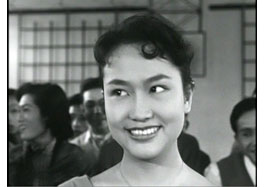 Yang is best remembered for a string of 1950s Mandarin-language movies set in modern Hong Kong; many sequences offer a virtual travelogue of the energetic, sun-drenched colony. Probably Yang’s most famous film is Mambo Girl (1957), starring the effervescent Grace Chang Ge Lan, but local audiences have a fierce sentimental attachment to his two-part historical romance Sun, Moon, and Star (1961). I’ve seen some of these in other thematic retrospectives, but this series is quite thorough. It includes films Yang wrote as well as ones he directed, and it will run through mid-May.
Yang is best remembered for a string of 1950s Mandarin-language movies set in modern Hong Kong; many sequences offer a virtual travelogue of the energetic, sun-drenched colony. Probably Yang’s most famous film is Mambo Girl (1957), starring the effervescent Grace Chang Ge Lan, but local audiences have a fierce sentimental attachment to his two-part historical romance Sun, Moon, and Star (1961). I’ve seen some of these in other thematic retrospectives, but this series is quite thorough. It includes films Yang wrote as well as ones he directed, and it will run through mid-May.
It’s hard to disagree with the severity of the program notes. “His films often suffer from loose structure and sloppy direction. . . Always professional but never a perfectionist. . . . Evan Yang is not a master, nor is he a great film artist. . . .” The impression, not wrongheaded, is of a Hong Kong Charles Walters. But Yang worked hard. In the Archive’s exhibition of his personal papers, you can see his tidy, artisanal dedication. The script pages on display include elaborate notations of shots (ls, cu, diss to…) and markings for repeated setups. It’s evident that Yang took pains to create his smooth, barely noticeable style.
 His effort shows on screen. His staging is clean and functional, though he is probably too fond of lining people up in rows. There’s seldom a self-consciously flashy shot or unstable composition. The emphasis is always on straightforward rendering of the melodramatic situations that drive his plots. A doctor falls in love with a patient who’s married (A Little Girl Named Cabbage, 1955). A clerk’s daughter is beautiful but mute, and the family needs money for her operation (The Beauty and the Dumb, 1954). A cat burglar trying to go straight runs afoul of his mercenary wife, who abandons their daughter and then returns to blackmail the family raising her (Blood Will Tell, 1954). Despite the all the adversity, however, things usually turn out well. In Madame Butterfly (1955), Yang updates the opera, making Pinkerton a Hong Kong businessman, and the string of pathetic coincidences swerves into a happy ending.
His effort shows on screen. His staging is clean and functional, though he is probably too fond of lining people up in rows. There’s seldom a self-consciously flashy shot or unstable composition. The emphasis is always on straightforward rendering of the melodramatic situations that drive his plots. A doctor falls in love with a patient who’s married (A Little Girl Named Cabbage, 1955). A clerk’s daughter is beautiful but mute, and the family needs money for her operation (The Beauty and the Dumb, 1954). A cat burglar trying to go straight runs afoul of his mercenary wife, who abandons their daughter and then returns to blackmail the family raising her (Blood Will Tell, 1954). Despite the all the adversity, however, things usually turn out well. In Madame Butterfly (1955), Yang updates the opera, making Pinkerton a Hong Kong businessman, and the string of pathetic coincidences swerves into a happy ending.
The musicals and comedies, although more light-hearted, still bear streaks of melodrama. What I had remembered about Mambo Girl is its fascination with that dance craze, but the plot actually has a serious basis: Grace learns that she’s adopted and sets out to find her birth mother, who turns out to be a nightclub singer. The breezier college romance Spring Song (1959) takes itself not at all seriously, but there is a persistent class antagonism between Grace and her rich rival.
Stylistically, Spring Song shows us Yang in a playful mood. There’s a visual gag during a scene in a coffee shop when our two male leads, Peter Chen Ho and Roy Chiao, wait for their girlfriends. Yang makes them mirror images, even timing the waiters’ arrival to create a funny framing.
Of course when the women arrive and see each other, comic misunderstandings ensue, also played out symmetrically.
Somewhat more subtly, Yang stages the opposition between Grace and Jeanette Lin Tsui during a meeting of classmates by putting the antagonists at extreme ends of a crowded frame.
The archive has produced a handsome book of Yang’s memoirs, in Chinese only, as well as an informative bilingual pamphlet on the retrospective. I hope to sample other items in the series before I leave next week; you know I won’t miss Yang’s take on spaghetti Westerns, Magnificent Gunfighter (1970).
Even if he weren’t such a solid craftsman, I’d respect his films’ sheer documentary value. When Hong Kong movies of the 1950s venture outside their rather creaky interior sets, they often yield up radiant images of a city on the rise. The scene in The Beauty and the Dumb showing Peter Chen Ho crossing the harbor, sitting happily in his sportscar on the Star Ferry, is enough to brighten your evening.
Spring Song, Mambo Girl, Sun, Moon, and Star, and other Yang films are available on DVD and VCD in English-subtitled, not-so-great transfers from Cathay.
Mambo Girl.
Stalking a roast duck
Lai Man-wai and Lai Buk-hoi. Photo from Hong Kong Film Archive Collection.
DB, still in HK:
The Hong Kong Film Awards will be celebrating 2009 as the centenary of Chinese film. Why this year? It’s long been said that the first local film was Stealing a Roast Duck, shot by a Chinese director and produced by an American film entrepreneur in 1909. Following received opinion, my book Planet Hong Kong claimed it as the first as well.
Which only illustrates the maxim that history will not repeat itself, but historians will repeat each other. The Hong Kong International Film Festival mounted a panel around several questions. Is it justified to claim 1909 as the start of Hong Kong cinema? Is Stealing a Roast Duck truly the first film? More ominously, did Duck exist at all? What follows are my interpretations of what the panel, moderated by Li Cheuk-to, came up with.
Law Kar, senior historian of Hong Kong cinema, and Frank Bren, an Australian actor/writer, have diligently pursued the Roast Duck question as part of a larger inquiry into the career of Benjamin Brodsky (erroneously called Brasky or Polasky) who later Americanized his surname to Borden. You can read earlier results of their research in their 2004 book Hong Kong Cinema: A Cross-Cultural View. There they review Brodsky’s filmmaking in China and Japan, but they’re cautious about the claims about his 1909 films. Stealing a Roast Duck “has been recorded as the first commercially made ‘Hong Kong film’ by a Chinese director. . . . Unfortunately, due to the non-discovery of any reports about filmmaking in China in any contemporary newspapers from Hong Kong or Shanghai, [Brodsky’s] story remains partly ‘mythic’ . . . .’ (pp. 37, 43).
At Sunday’s panel, Law and Bren reviewed their most recent research. Law noted that Roast Duck enters film historians’ writings quite a bit after the fact. The crucial mention comes in an article in Cinema Almanac of China 1927, published in Shanghai. Even that article did not specify that Roast Duck was filmed in 1909, only that it was one of four films made by Brodsky’s company, which was founded that year. Law went on to trace how later print sources, mostly books and survey articles, elaborated on these points. By 1936, Roast Duck was said to be one of two 1909 films produced by Brodsky in Hong Kong. Later historians recast the claims again, promoting Roast Duck to the status of Hong Kong’s first story film.
The problem is that there appear to be no contemporaneous sources that can resolve the matter. Law, Bren, and other scholars have found no advertisements, announcements, catalogue listings, or other print documents in 1909 mentioning Roast Duck. Moreover, a 1916 interview with Brodsky, conducted by no less a figure than George S. Kaufman, makes no mention of the film. Brodsky mentions The Empress of Dowers (probably The Empress Dowager) and The Unfortunate Boy , two films he made in China, but gives no specific year of production. Since the piece was written to promote Brodsky’s most recent efforts, it would have been in his interest to play up any pioneering role in Chinese cinema he might have had.
Frank Bren’s presentation was a fascinating detective story. Bren has chased Brodsky through the Internet, Social Security records, city directories, and many other data sources. The efforts yielded the outlines of the remarkable story of a Russian-born American who went to Asia in hopes of setting up film businesses there. Brodsky evidently did produce a Hong Kong film, Chuang Tzu Tests His Wife (1913 or 1914), which involved local filmmakers Lai Buk-hoi, Lai Man-wai, and Lo Wing-Cheung. Chuang Tzu is sometimes considered the earliest true Hong Kong fiction film.
Brodsky was also a documentarist, making two feature-length travelogues, A Trip through China (1916) and Beautiful Japan (1917). He died in 1960 in California. Bren continues to research this colorful figure, being especially fascinated by Brodsky’s unpublished autobiography.
The upshot of this research? There is no positive or direct evidence that Stealing a Roast Duck was made in 1909 or was the first Hong Kong film.
Perhaps it was not made at all? Wong Ain-ling, Research Officer at the Hong Kong Film Archive, is not willing to go so far. She is quite convinced of the existence of the film for several reasons. Apart from the references Cinema Almanac of China 1927, she notes an article published in HK in a 1924 New Bijou Theatre Newsletter, often overlooked for some reason or other. The latter reports: “A Russian [Brodsky?] arrived in Hong Kong in 1912 and cast Mr. Leung Siu-po in Stealing a Roast Duck, one of several slapstick films. Shortly after, Lai Man-wai was cast in Chuang Tzu Tests His Wife and The Ghost of the Pot Returns.”
Wong Ain-ling also cited the testimony of veteran filmmaker Moon Kwan, in both his 1976 book Unofficial History of the Chinese Cinema and his oral records with film historian Yu Mo-wan (as recorded in Yu’s Historical Account of HK Cinema, vol 1). Moon Kwan indicated that he watched the Roast Duck alongside Chuang Tzu Tests His Wife in Hollywood in 1917 (or perhaps 1915). In some detail, he recalled the story of the film and the cast, with Leung Siu-po in the role of the thief, Wong Chong-man as the hawker of roast ducks, and Lai Buk-hoi as the policeman.
As for the year of production, Wong finds 1909 quite shaky; 1912 as cited in the New Bijou Theatre article seems a bit closer. That date is also more consistent with the biography of Brodsky. She concluded her remarks by asking whether it is so important to have a celebration or centenary.
I was asked to sit on the panel as well. All I suggested was that there are problems with determining “first films” in any national cinema tradition. There are empirical difficulties—matters of fact, we might say. Most silent films are lost, and paper records are incomplete or destroyed, so it’s quite likely that any country’s earliest productions could be undocumented. Hence we often have to rely on memories, oral history, word of mouth, and collective opinion. Such seems to have been the case with Stealing a Roast Duck.
There are conceptual difficulties about firsts too. What will count as a film? There were many documentaries and newsreel films made in Hong Kong before 1909, some by Hong Kongers. Why are these not candidates for first films? Because, I suggested, we tend to think of “real films” as telling fictional stories by staging the events. Stealing a Roast Duck would fulfill that condition.
The first volume of the Hong Kong Film Archive filmography has taken care to specify what conditions make something a first film in some respect. Chuang Tzu is called Hong Kong’s first “two-reel” film and its first “fiction” film. The Calamity of Money (1924) is described as the first Hong Kong film to be publicly shown in the colony. Rouge (1925) is labeled “Hong Kong’s first feature-length fiction film.” All of these films are, of course, currently lost.
I added that we select firsts on the basis of our assumptions and purposes. We assume that fiction films are more central instances of cinema than newsreels, or that films directed by Hong Kong people are more central instances than those directed by visitors or residents. And sometimes we want to celebrate cinema, so we create a pivotal anniversary: an example is the one hundredth anniversary of cinema (held in 1995, when we could also have done it in 1994). The effort to create a centenary, which in turn generates public interest in Hong Kong film, has settled on a story that suits that purpose.
It’s fun to imagine what a 1909 Stealing a Roast Duck might have been like. A one-reeler, maybe, built around a string of gags. Perhaps the thief makes many efforts to hitch the duck off the rack, before finally succeeding and being chased through the streets of Hong Kong by the cop. The duck becomes a football tossed from one party to another. . . .
More seriously, you have to be impressed with the care with which my fellow panelists exhumed and dissected their evidence. As usual, the closer you look, the more complicated any issue becomes. One of the pleasures of studying film history is that it can surprise us.
An excerpt from Brodsky’s Beautiful Japan is included on volume 1 of the DVD collection Treasures from American Film Archives. A Guardian interview with Law Kar about Stealing a Roast Duck is here. Thanks to Frank Bren for help with access to illustrations.
Law Kar, Wong Ain-ling, Li Cheuk-to, Frank Bren, DB.
A masterpiece, and others not to be neglected
About Elly.
DB still in Hong Kong:
I haven’t been slack, honest; I’ve caught several items at the archive and during the first weekend of the Film Festival. I even saw Watchmen, accompanied by rump-shaking Shaw Active Sound. But today let me get caught up with some films I saw in Filmart last week.
I was unimpressed by the picture that launched Filmart, Derek Yee’s Shinjuku Incident. Billed as Jackie Chan’s emergence as a real actor, it features him as a confused illegal immigrant thrown into the Tokyo underworld. His character never made sense to me, and the direction was formulaic: basically pan around a group of actors until somebody says something. Daniel Wu gets to play another maniac.
Less heralded Filmart screenings were much more satisfying. The best, and my favorite film I’ve seen so far this year, was About Elly. It is directed by Asghar Farhadi, and it won the Silver Bear at Berlin. I can’t say much about it without giving a lot away; like many Iranian films, it relies heavily on suspense. That suspense is at once situational (what has happened to this character?) and psychological (what are characters withholding from each other?). Starting somewhat in the key of Eric Rohmer, it moves toward something more anguished, even a little sinister in a Patricia Highsmith vein.
Gripping as sheer storytelling, the plot smoothly raises some unusual moral questions. It touches on masculine honor, on the way a thoughtless laugh can wound someone’s feelings, on the extent to which we try to take charge of others’ fates. I can’t recall another film that so deeply examines the risks of telling lies to spare someone grief. But no more talk: The less you know in advance, the better. About Elly deserves worldwide distribution pronto.
Also worth seeing was A Place of One’s Own, a Taiwanese film that uses imagery of living spaces to explore generational differences. As a young rock singer’s career fades, his pop-star girlfriend’s career takes off. Their fates are intertwined with those of a family who live near a cemetery. The father makes exquisite paper dwellings that are burned during funeral ceremonies, the mother maintains gravesites (and talks to ghosts), while the son launches himself on a real-estate career with the help of a dodgy rich kid. Director Ian Lou (God Man Dog) enhances this network narrative with some clever flashback constructions as well.
My Dear Enemy.
Two films I saw in the market display different ways of using past incidents to explain a story’s present-time crises.
My Dear Enemy, by Lee Yoon-ki, exhibits a striking concentration and dramatic focus. Hee-soo’s boyfriend Cho borrowed $3500 from her before they broke up. Today she has tracked him down and demands it back. She drives him around as he visits various associates—his biker cousin, a high-class prostitute, a rich older woman who seems to be using his sexual services, an unmarried mother—scrounging for money to pay Hee-soo back. Across a day of setbacks both comic and frustrating, we come to learn of their romance and their deeper personalities.
At first Cho seems the classic annoying charming rogue, chattering about the music he likes, pausing to buy flowers and oversweet coffee, flattering every woman he meets, and on the verge of ducking Hee-soo’s demands. Every time he gets out of the car, you think he might bolt. These first impressions, however, get nuanced as we see how he moves easily and even gracefully through his milieu. He seems a loser, but we learn that he is resilient and resourceful. Meanwhile Hee-soo’s righteous determination to get her money back comes to seem something of a desperate effort to close the book on painful episodes from her past.
Lee Yon-ki, who earlier gave us This Charming Girl, is very good at structuring scenes so that we understand every character’s changing attitudes. To get the money, Cho lets his target think that he’s helping out Hee-soo, and at one point he implies that she’s pregnant. As Hee-soo realizes that he’s making her play a part in his drama of self-aggrandizement, she is hurt and ashamed. And Cho’s happy-go-lucky facility in his milieu makes her feel more of an outsider. One scene, in which Cho’s hooker friend calmly insults Hee-soo, is a subtle study in casual humiliation.
Yet Hee-soo’s tenacity wins Cho’s respect. At the same time, while as the day passes into night, Cho emerges as a figure with his own code of honor (he eventually provides a meticulous account of what he’s cost her in the day’s expenses) and even a dream of success that might, the last shot suggests, be fulfilled. Bits of business around coffee, cellphones, flowers, and a broken windshield wiper chart the fluctuations in their relationship concisely. My Dear Enemy is a model of how to make a tight, intimate movie focused on simple incidents that carry almost Hitchcockian tension: Will Cho pay Hee-soo off? Will he slip away and abandon her again? What will we learn next about each one’s past? Like About Elly, this is a character study with an engrossing plot.
More diffuse, I thought, was Ann Hui’s unfortunately titled Night and Fog. It’s a companion piece to The Way We Are, her 2008 study of life in the Tin Shui Wai area of Hong Kong. I offered an admiring account here.
This is the “darker story” Ann promised us at last year’s festival, and it’s based on an actual case. Lee Sum has married a Mainland woman, Ling, and has fathered two daughters with her. He’s on social security and Ling works as a waitress. But Lee is considerably older, and he suspects her of flirting with other men. He becomes insanely jealous, beating her and throwing her and their daughters out. Ling finds happiness in a woman’s shelter, but social services fail her and Lee brutally murders her and the children.
No harm in telling you the ending because the murder is the first thing we see. The film consists of a series of flashbacks, some nested within others, that trace what led up to Lee’s horrendous crime.The plot is presented in the framework of a police investigation, with witnesses to Ling’s life answering questions that pass into scenes from the past. The early flashbacks are quite linear, treating the buildup to Ling’s stay in the shelter and a moment in which she sings a song about a mushroom maiden. Then we plunge further into the past, showing her leaving her provincial home as an adolescent on the way to work in the city. Soon we’re given early moments in Lee’s courtship of her.
One effect of introducing the early stages of their marriage late is to mitigate the harsh portrayal of Lee that has dominated the first half of the film. He seems genuinely in love with Ling, and he rebuilds her parents’ home. Already, however, we glimpse his drunkenness, his sadism, and his aggressive sexual appetites.
On the whole, I’m not sure that this complicated flashback structure serves the film well. At times it is strikingly symmetrical, as when a scene of Lee returning from Shenzhen on the train is followed by a distant flashback of the marriage, and this is closed off by a shot of Ling and her daughters traveling on the same train. At other points, though, the relation between the witness’s testimony and the flashback episodes is arbitrary, with the flashbacks showing scenes unrelated to that witness’s knowledge of the family drama.
It seems to me as well that the power of the events leading up to Lee’s murder of his family is vitiated by the protracted Mainland visits, widening the film’s field of view to life in Sichuan and Ling’s family. Where My Dear Enemy lets its backstory emerge in piecemeal fashion through hinting dialogue, dramatizing every relevant moment in Ling’s past seems to lose some focus.
Likewise, there’s a certain fuzziness about the film’s main thrust. Is it a character study, trying to explain why Lee is violently jealous and why Ling stays with him? The only clear answer I could determine was her sense of indebtedness for his help to her parents. Is Night and Fog then best taken as a critique of the Hong Kong bureaucracy? The social workers are portrayed as indifferent or unable to understand domestic violence. But in that case we need to see more of the mechanisms of decision-making than we do, and then many of the intimate relations of the couple would be extraneous. The battered women’s shelter, while not unblemished, becomes the opposite pole to Ling’s dangerous household, and Huipresents it as a safe space where women can express their feelings spontaneously. But again, this angle on the material seems vitiated by bringing in a public protest against real-estate development of the harbor area—an important issue, but in the context a bit distracting.
The film seems to me to excel in areas that Hong Kong cinema has made its own: extreme emotion and sheer physicality. The violence of Lee’s assaults on his family are terrifying, and Simon Yam’s performance is tremblingly ferocious. Smoking furiously, swigging cans of beer, Yam gives us Lee Sum as a figure on the edge of destruction. He makes even fishing seem an act of aggression. Lee’s incessantly jiggling leg is like the timer on a pressure cooker, and when he sits down with his son from a previous marriage—a sleepy-eyed young pimp—the two of them share the same foot-jiggling tic. In this shot, Hui gives us a diagram of male aggression ready to burst.
If My Dear Enemy trades on suspense, Night and Fog creates dread. One is roundabout, the other more direct; one suggests much, the other shows everything. Two ways, we might say, of making modern cinema.
More, including another Iranian masterpiece, in my next communiqué.
Night and Fog.












